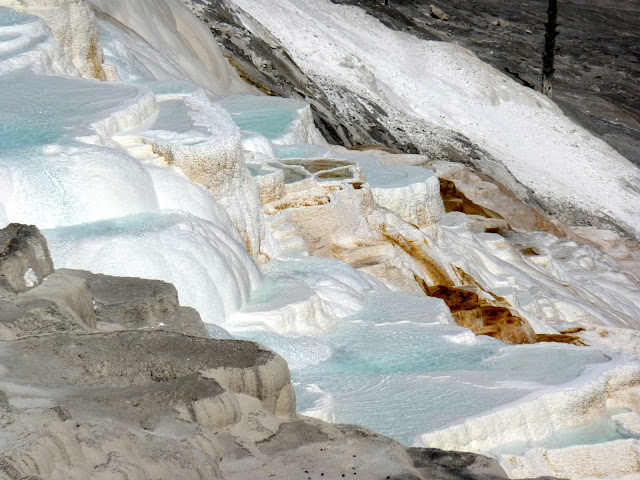 |
| The Midway Basin with the Grand Prismatic Spring (left) and the Excelsior Geyser Crater pouring into the Firehole River |
On September 6th, 2010, Bill hitched up the R-Pod and we set out on a 12-day road trip to see, for the very first time, Yellowstone National Park. It has five entrances (we arrived from the west) and a road system in the figure of eight. The Visitor Centres and Museums are very well done. We saw a great deal, but not all of the park.
 |
| The colour of some of the hydrothermal pools is remarkable! |
To deal with the huge number of visitors it gets, Old faithful has its own overpass! The Rangers are very accurate in their predicted times of eruptions which happen anywhere from 40 - 126 minutes apart. Along with 300 other people we saw her blow only minutes after the predicted time of 5:22PM.
 |
| Our shadows cast on a bacteria mat of one of the geyser pools at Midway Basin |
 |
| Mammoth Hot Springs was just that |
Odd and magnificent as they are we tired of the geysers rather quickly and went looking for something else.
 |
| The Grand Canyon of the Yellowstone River |
The Grand Canyon of the Yellowstone River ranges in depth from 800 to 1200 feet. Climbing in the canyon is not permitted and for just reasons; it is steep, gnarly and dangerous. There are many drive up lookouts and descending trails on both the north and south rims - with steps, to take you down, about 500 feet, into the canyon. "Uncle Tom's Trail" on the south rim has 328 steps!
 |
| Stunning view of the canyon from Grand View Lookout, north rim |
We loved the canyon so much we went back two days in a row! From the Red Rock trail on the south rim, this is as far down into it as you can safely get. And, as it was we were somewhat off piste here ...
 |
| The exquisite Lower Falls of the Yellowstone River |
For the entire photo essay please click here.
And then we went off into Grand Teton National Park ... that story to follow!





















